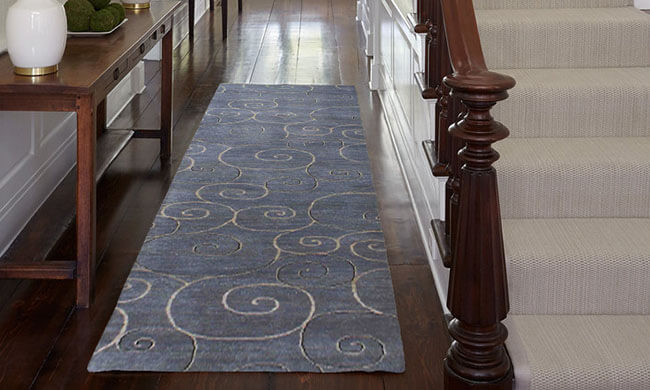5 Innovative Ways to Style Your Runner Rugs
Runner rugs are an enigmatic decor element.
Many people are uncertain how they can be styled within the walls of a home, and instead of trying to find the best arrangement possible with these elongated variants, they do not go through the process of learning about them.
In this post, we discuss 5 ways you can style your runner rugs for the worthy cause of holistic design in your living spaces.

1. Create Axes of Movement
One of the most important functions of a runner rug is to frame an axis (or axes) in your home.
Given their elongated proportions, their placement implies a pathway your guests can sense while entering a room. This creates a suggestive logic within the living space, ordering against the possibility of chaos. People will understand how they must move within the room, and how to move to the rooms beyond.
Runner rugs, for this reason, are often placed near doorways and entryways, in foyers and waiting rooms—which brings us to our next point.

2. The Rug’s Position Follows Its Function
One position of a runner rug is generally set at the threshold of the house, often continuing into the hallway. Why is this? It sets the tone for the directional patterns of the house, from outside to inside. As mentioned above, a runner rug’s main function is to frame an axis, and this is best sensed at the entrance.
And it can also set the tone of other elements of the home decor. For example, if your house is decorated and designed with classical themes, your runner rug can set things off with its classical pile design. Other natural positions for runner rugs are the other circulation spaces of the house, such as hallways, passageways, and corridors.

3. Customize the Size to Room’s Scale
You can customize the rug’s size to the scale of your room and the other elements, such as area rugs and furniture.
Supposing your home has a large, open drawing room whose adjacent rooms are not instinctively visible. You can scale up the runner rug’s design to solidify the axis required to lend logic to the room’s greater volume. Similarly, a smaller bedroom can have its runner rugs scaled down and placed to and from the attached bathroom or balcony.
4. Be Mindful of other Interior Elements
Runner rugs have immense potential to be paired with other interior elements.
Be mindful of the borders. Make sure runner rugs do not clash with the walls or furniture. Leave space on the rug’s sides so that it doesn’t curl up against the walls. Unlike area rugs, runner rugs should not be placed under furniture. Their function is not as an anchor of the space, but as an accent or as a direction-indicator.
5. Colours Disrupt or Reinforce Room’s Colours
Each room has a unique colour theme.
To create favorable aesthetics, colours of the runner rug can vary as per your preference. Generally, there are two methods to assert your preference. You use the rug’s colour to reinforce the colours already displayed in the room. Or you use the rug’s color to create a disrupting effect, that either brings out the room’s colours (if the rug’s colour is subtler and toned-down) or brings out the rug’s colours (if the rug’s colour is brighter).
There are also technical aspects you will need to be mindful of, though these do not fall strictly within the purview of “styling.” Lower piles are preferred for runner rugs, as runner rugs are usually placed in areas of high traffic where tearing and unravelling can create a tricky situation. For the same reason, stronger textile materials like wool (instead of silk) are used in the making of runner rugs.
Should you need advice on these nuances, you can always check with experts in the industry, such as the consultants at Cocoon Fine Rugs. We will provide the best information for you to make your pick!
